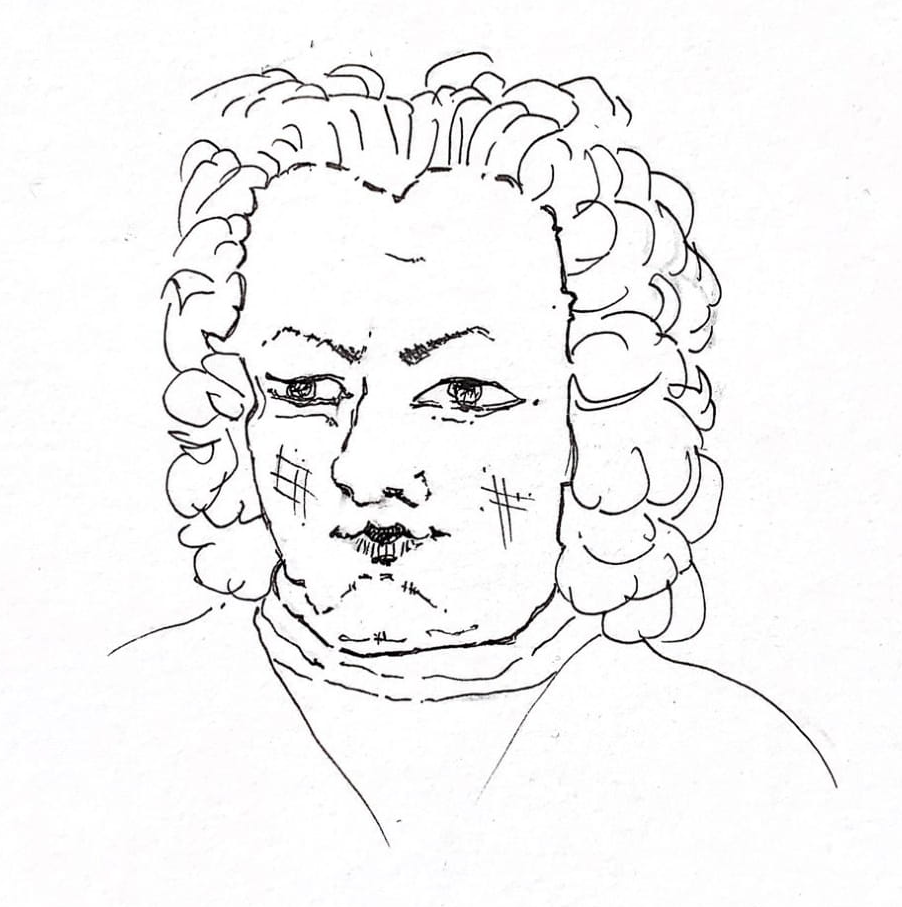6 section cantata, -concertante opening movement, 2 x aria, 2 x recit and closing choral.
As far as the orchestral forces, in this cantata go, Bach show’s himself to be a master of limitation, as the band is reduced, -2 x oboe d’amore, strings and continuo. A single cornetto is used to reinforce the chorale melody, in the first and last sections.
1/(chorus)
‘I rejoice in you and say welcome, my gentle Jesus. You have decided to be my little brother.
How sweet!
How friendly He appears, this great Son of God.’
This splendid opening presents the text in 4 part harmony, only in the sixth line, ‘…how sweet,’ and the eight line, ‘…this great son…’ does Bach release himself, to create, some counterpoint.
The joyful, trumpet-like semiquaver figure, -oboes, violins and violas doubling themselves, reflect and colour, these majestic, opening words.
Whilst the chorus is circumspect, as regards contrapuntal activity, these instruments are imaginative and varied in their musical invention, although the cornetto helps to present the soprano chorale line, always, as the dominant force.
This short and ‘busy’ movement, reflects here, the concertante nature of the approaching new year and that feeling, of ‘work-to-be-done’, which comes, with the nature, of a praising and worshiping Christianity.
2/Aria:
‘Be of good cheer! A holy body, encloses this most unimaginable and intriguing person.
I have seen God, -how lucky, am I! face to face.
My soul must be preserved.’
,Getrost’ is the pace that is here set, by our alto voice, -notice this at 19, those opening semiquavers, continued from and imported from, the opening.
The incomprehensibleness of The Messiah is well represented and reflected, in the rising pitch of the voice, at 23.
The ‘harmony‘, socially speaking, between the 2, now solo, oboes, reflects the face-to-face-ness, between God and man, and that face-to-face-ness, reflected, in the God-human face of the newly born Christ, all nicely demonstrated by the pleasing writing, at 42 through 47.
Notice the anxiety displayed, with regard to, the preserving, -or the healing, of the soul, 58, soon to be dispelled at the written out da-capo, 68.
3/Recitativo:
A secco, with 2 chorale insertion:
‘An Adam, may, -when filled with terror at seeing The Christ, try to hide, in paradise.
(C) The most High-God, Himself, comes to lodge, with us.
So, my heart feels no fear. It knows His merciful cast of mind, and His immeasurable goodness.
(C) He becomes a little child and sweet Jesus, is His name.’
An initial terror is dispelled, as the mood settles, into the written-in adagio.
Any hint of further upset is off-set, by consideration of the
‘…merciful cast of mind…and immeasurable goodness’,
and this short rectitativo-arioso, end,s in an adagio contemplation, of the young Messiah.
4/Aria:
‘How lovely are the sounds, of these words, in my ears:
My Jesus is born!
They penetrate my heart.
Whoever cannot comprehend Jesus’ name, and whose heart is not overjoyed, by that name, must be as hard as a rock.’
This is a trio, -bass, top line, strong first violin part, which is reduced to a solo fiddle, 17, with vocal line.
The short, clipped and angular nature, of the phrasing, is designed to reflect, the hard rocky nature, of the unbeliever.
We hear the trumpet-like fanfare for the hearing-ear, 24/25 and at 27, the intoned, choral-like words, ‘My Jesus is born.’ and finally, the penetration of the heart, 50 through 53.
At 61, at a written tempo change, down to Largo, we enter a new world, where angular and hard-edged phrases are replaced with shaped and soft toned ones.
The heart, evidently, comes in all textures.
This soft and pliable 12/8, sicilian time, is ironic, as the text is talking about the hard-hearted nature.
As the solo voice sings, the (solo?) violin muses, and all in a strange, drifting world, where phrase lengths are distorted, -61 through 66, and long, lonely and ethereal vocalisation, on the word ,harter’, seems, almost desirable.
5/Recitativo:
‘Well. My comforted heart, is not considering, the pain and fear, of death. If He comes down from heaven to earth, He will surely be thinking, of me, in my tomb.
He who knows Jesus well, does not die, -when he physically dies, provides he calls, on the name, of Jesus.’
This secco recit is narrative in its approach, until the written adagio, where the words,
‘he who knows Jesus…’
precipitate an arioso, chorale-like line, in structure and in mood, where the fate, of the true believer, is revealed and proclaimed.
6/Choral:
‘So, I would cling to you, Jesus, even though the world should split, in a thousand ways.
For you, -and just for you, alone, do I live.
In you, -and you alone, will I sleep.’
This chorale is all about sleep and peace. There is no musical reference at all, to the earth fracturing or splitting; a model harmonisation and harmony, a close moving, four part realisation.
In-fact, there are, within reason, hardly any parts, or changes, that do not move, entirely by step.
Well done Bach!
